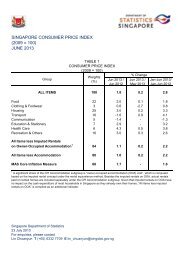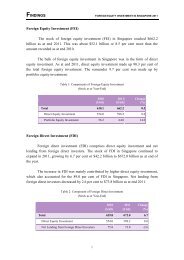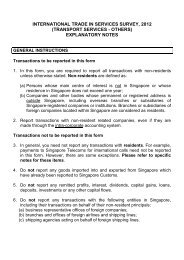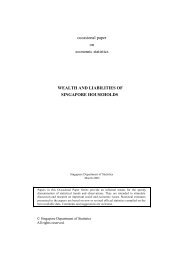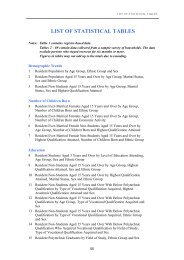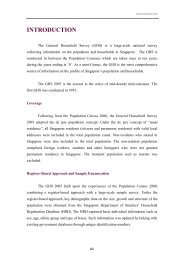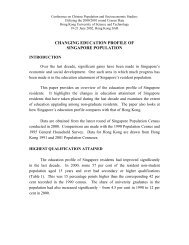Paper - Statistics Singapore
Paper - Statistics Singapore
Paper - Statistics Singapore
- No tags were found...
You also want an ePaper? Increase the reach of your titles
YUMPU automatically turns print PDFs into web optimized ePapers that Google loves.
Complete Life Tables 2003-2006 for <strong>Singapore</strong>’s Resident PopulationIIntroduction1. Current life tables depict the mortality experience of a given population,based on the assumption that this group is subject to the age-specific mortalityrates of the reference period throughout their lives. Life expectancy of persons atvarious ages are derived from life tables, and shows the average number of yearsthat persons (at birth or at a specific age such as age 65 years) might expect to liveif they experience these mortality rates. The derived life expectancies give anindication of the average longevity of the population, but do not necessarily reflectthe longevity of an individual.2. Life tables can be classified into either complete life tables or abridged lifetables according to the length of the age interval in which the data are compiledand presented. A complete life table contains data for every single year of age. Anabridged life table contains data at 5-year or 10-year age intervals. Abridged lifetables are more commonly produced than complete life tables, and are sufficientfor most purposes when the degree of detail needed is not so great.3. The <strong>Singapore</strong> Department of <strong>Statistics</strong> (DOS) has been compiling annualabridged life tables that provide data at 5-year age intervals and up to age 85 yearsand over. With the growing proportion of elderly persons in <strong>Singapore</strong>, and thegreater demand for data at specific ages, there is increasing need for complete lifetables covering single years of age up to age 100 years and over.4. DOS has concluded its review of methodology for constructing completelife table and has compiled the complete life tables for <strong>Singapore</strong> for the years2003-2006. This will be an improvement over the abridged life tables as data forsingle years of age will be available instead of the current 5-year age groupingsand for older ages beyond the current age cut-off of 85 years.5. DOS's release of complete life tables is consistent with the practices inother countries which issue new/revised life tables based on more refined methodsof constructing life tables. For example, the US National Center for Health<strong>Statistics</strong> started to compile complete life tables annually and changed fromclosing age 85 years and over to 100 years and over since Dec 1999 1 , prior towhich abridged life tables were produced annually with lower age cut-off at 85years and over. The Australia Bureau of <strong>Statistics</strong> revised its life table1 National Center for Health <strong>Statistics</strong>. Vital Health and <strong>Statistics</strong> 2(129). 1999, Method for ConstructingComplete Annual U.S. Life Tables. http://www.cdc.gov/nchs/data/series/sr_02/sr02_129.pdf1




